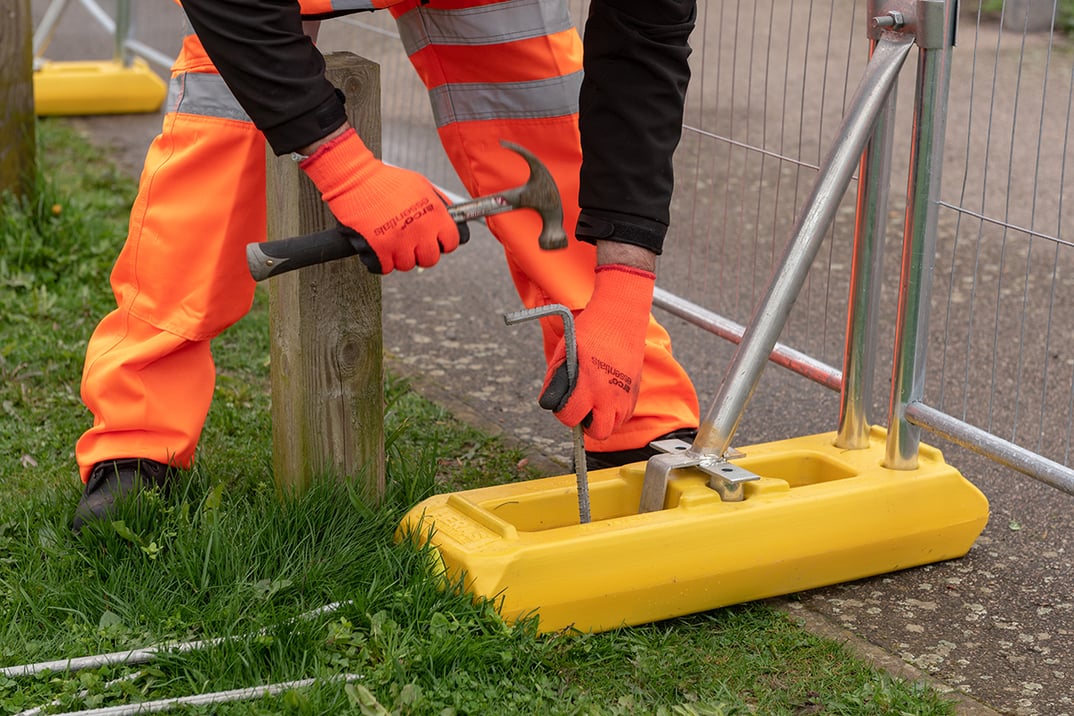In high wind areas, your temporary fence panels can — if not installed correctly — turn into dangerous obstacles that could pose a threat to the safety of personnel and members of the public. To prevent accidents from happening and avoid damage to your fences, proper installation and stability accessories are essential. Do you want to rely on the way your fence line is situated while staying in budget and increasing construction site safety? Here’s how to do so.
What are the consequences of high winds for temporary fencing?
When not equipped with stabilising equipment, temporary fences are an easy victim of high winds. When strong winds blow over one of your fence panels, it’s likely the rest will follow. Interconnected fences work like a domino: only one of your fences needs to catch a lot of wind for all of them to fall over.
Falling fence panels cause a serious threat to the safety of your personnel and members of the public. Not only can people be hit by a falling panel, but the fallen fences can form an obstacle that can increase the chance of accidents happening. In the image below, you can see how a series of fallen fence panels can cause dangerous situations.
.jpg?width=600&name=IMG_1952%20(1).jpg)
Why it is crucial to stabilise temporary fences
Equipping your temporary fence panels with stability enhancing accessories helps you increase construction site safety when building in a high wind area. And that’s not the only advantage of stabilising your temporary fences:
- Security of site: equipping your fence panels with stability enhancing accessories, like struts and weight blocks, helps you to keep unwanted guests from your site. Extra stability means that it is far more difficult to push fences over or lift them up, which makes it almost impossible for thieves or vandalists to create an opening to enter your site.
- Your staff can concentrate on construction: a fence that keeps falling over due to high winds has to be lifted up and reinstalled over and over. This takes up much time from your staff, while they should be able to concentrate on construction. Stabilising your temporary fence panels enables your staff to do what they do best.
Please note that when you use solid fence panels or you have banners attached to your fences you should always use stability equipment. Since these type of fences catch significantly more wind, they form a more significant threat to the safety levels on and around your construction site.
Methods of increasing fence stability: how not to do it
Weighing down temporary fences can be done in a various way. Needless to say, some methods are safer than others. In an attempt to save time and costs, over the years I’ve seen various creative — but unsafe — ways of increasing fence stability.
From loose bricks being piled up on the base of a fence to wooden planks used as a strut: many constructors lower the safety level of their site by using improvised stability methods.
In the image below, you’ll find a few examples of how not to increase the stability of your fence. In the next paragraph, I’ll discuss which steps to take to make sure you correctly stabilise your temporary fencing.
How to correctly stabilise temporary fencing
To select the right stability method for your temporary fencing, you first need to know which wind speeds your fences have to withstand. At Heras Mobile, we can calculate the wind load of your construction site based on your postal code.
The wind speed determines the weight you will need to stabilise your fencing. Based on this information, you can choose the kind of stabilising system that is most suitable for your building site.
The choice between various stabilising systems is not only dependent on the wind speeds on your site, but also on how much space you have available and how much you want to invest. Overall, there are several accessories you could use:
- Fence stability braces: prevent your fencing from falling over with stability braces that are attached to your fences.
- Ground spikes: attach your stability braces firmly to the ground by using ground spikes that can be pinned into soft undergrounds.
- Strut systems: simultaneously increase the stability of your fence while making sure your fences cannot be lifted up by connecting your fences to the base using a strut system.
- Stabiliser base: you effectively weigh your fences down with the help of stabiliser braces.
- Reflective strips: for increasing the visibility of your temporary fencing, even at night.
At Heras Mobile, we’ve combined several tried and tested stabilisation accessories and used our knowledge and experience to develop the Stormguard system that helps you increase overall stabilisation. With its unique strut system, the Stormguard system can withstand up to 100 mph winds with mesh and up to 70 mph winds on hoarding. Especially when using solid panels, like our Readyhoard screening fences, the Stormguard system can play an essential role in securing your panels in high wind areas and increasing safety on your site.
Combining all these accessories into one system that is compatible with the type of fencing you’re using can be a time-consuming and challenging task. At Heras, we are there to assist you in finding the most suitable stabilising system for your site.
A Heras Mobile wind loading specialist will analyse your specific situation, conduct all the necessary calculations and provide you with comprehensive advice on the fencing solution that suits your project in the best and safest way possible.
Request your free wind loading advice here:



